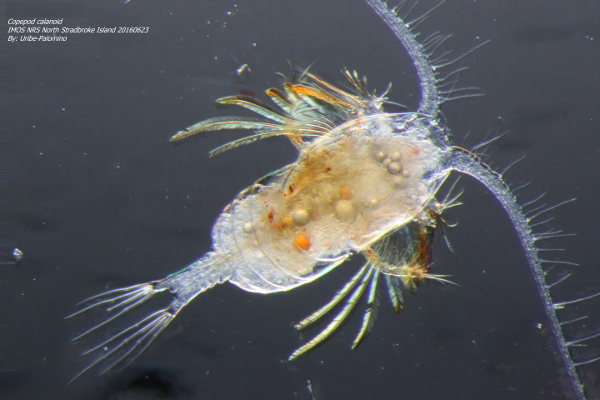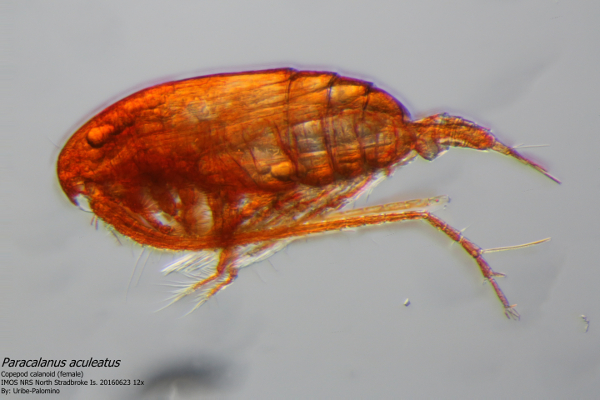For marine ecologist, Professor Anthony Richardson, it was the copepod populations off southeastern Australia that began raising concern about the future of fish stocks—and the entire marine ecosystem—under ocean warming.
Copepods are tiny shrimp-like zooplankton that swarm the ocean’s surface. In fact, they're more abundant on the planet than insects, putting them at the very centre of many marine food webs.
By analysing 40 years of ocean sampling data—publicly available through Australia’s IMOS (Integrated Marine Observing System) program—Richardson discovered that tropical and sub-tropical copepod populations previously restricted to NSW coastal areas were migrating south to Tasmania and flourishing in the warming waters there.

It wasn’t just the copepods, although to fish stocks they are critical. Other tropical and sub-tropical plankton—the mass of mostly tiny plant and animal life at the ocean’s surface that props up the entire marine food chain—were drifting polewards, displacing cold-water species.
Alarmingly, they hadn’t just shifted their range by a few kilometres, but by hundreds of kilometres—300, in fact. Plankton can only move via currents near the ocean’s surface. In this case, they were riding the warm East Australian Current (EAC), which itself has pushed 300 km polewards over the past 60 years—largely, scientists believe, as a result of climate change.
A destabilising food web
Richardson, a CSIRO scientist and professor in mathematics at the University of Queensland, believes the climate-related displacement of cold-water zooplankton (planktonic animals) by warm-water ones has ramifications for the fishing industry, for biodiversity, and for the marine environment generally.
“Data from historical samples, from the ‘70s, ‘90s and 2000s, were dominated by cold-water copepods. The cold-water copepods are large and provide good food for fish,” he explains.
“What we've documented over the last eight to nine years is that the copepod community off eastern Tasmania has become dominated by tropical and sub-tropical species more typical of NSW waters. These tend to be smaller, so they're not as good a food source for fish.”

If the EAC moves further south and the ocean continues to warm, more tropical species are likely to expand into cooler waters to the south-east and south of Australia. The result, warns Richardson, will be smaller-sized plankton, providing less food for the fish, sea birds, crustacea and marine mammals further up the food chain.
“Basically, the entire marine food web is supported by plankton productivity, and if that's going to decline, it's a problem.”
For Richardson, the systematic collection of new data from the past nine years through IMOS has been a game-changer in his ecological modelling work. IMOS—a national collaboration involving universities, the CSIRO, the Bureau of Meteorology and other research agencies—makes data from regional-scale marine studies freely available to Australian scientists, international collaborators and other stakeholders, such as PhD students.
“We didn’t have time-series plankton sampling in Australian waters before IMOS, so we didn't know what was happening in terms of changes over time,” says Richardson. “Now we've got nearly 10 years of time-series data, so it's a start.
“But we will probably need 20 years of time-series data to be confident about climate signals. So, we combine the IMOS data from historic work done by scientists during one-off surveys.
“We are increasingly using ecosystem models so that we know how the marine environment is changing, and these need to be continually updated with data. If they're not, they're not going to be useful. You need to keep monitoring so you know the reality.”
Biological pump
Plankton perform many other ‘ecosystem services’ for the planet. For example, phytoplankton (planktonic microalgae) produce around half the oxygen we breathe every day—more than tropical rainforests.
Plankton also transport carbon from the surface to the ocean depths in a process known as the biological pump. Carbon fixed by phytoplankton through photosynthesis is transferred to zooplankton grazers and fish, sinking to the deep ocean floor as faeces or decaying animal matter where it is quarantined from the atmosphere for thousands to millions of years.
Ecosystem models indicate that ocean warming may slow or stop the biological pump that keeps carbon sequestered in the deep ocean.
“The concern now is that as the top part of the ocean warms, the surface water becomes less dense, meaning the colder, heavier, nutrient-rich water down below is harder to get up,” says Richardson.
“If there's fewer nutrients coming up because of warming, there'll be less plankton around and that means less food for fish. It also means less CO2 drawdown, which means more CO2 staying in the atmosphere, which will in turn accelerate climate change.”
‘Gatekeepers’ of food web efficiency
One of the most intriguing insights from Richardson's research is the pivotal role that different zooplankton play in the marine food chain.
He says zooplankton are like gatekeepers in making food webs efficient or inefficient.
“Some zooplankton eat things 100,000 times smaller than them, and then are eaten by fish. That's a really efficient transfer of energy. But other zooplankton will only eat things 10 times smaller than them. If you've got those zooplankton in the food web, you're losing a lot of energy at every trophic step and you get very few fish at the top end.
“That's going to be a really big topic for investigation in the future, that the efficiency of food webs in converting phytoplankton material into fish depends on who the zooplankton in the middle are.”
Read the highlights of the Marine chapter from the 2016 State of the Environment report.
